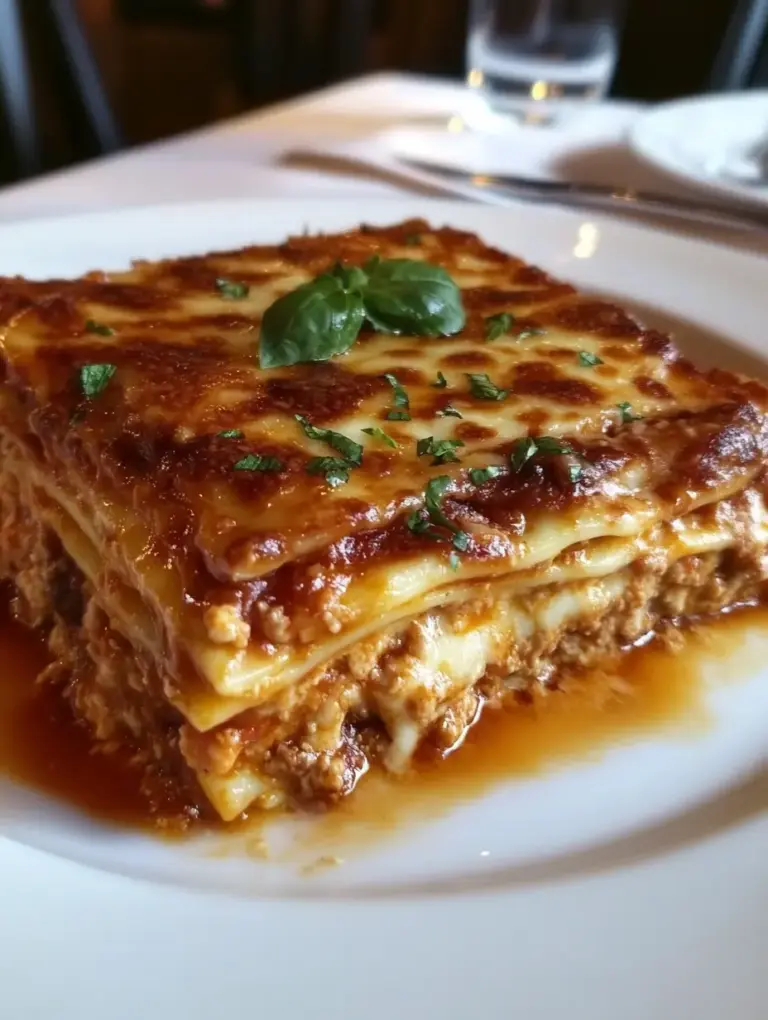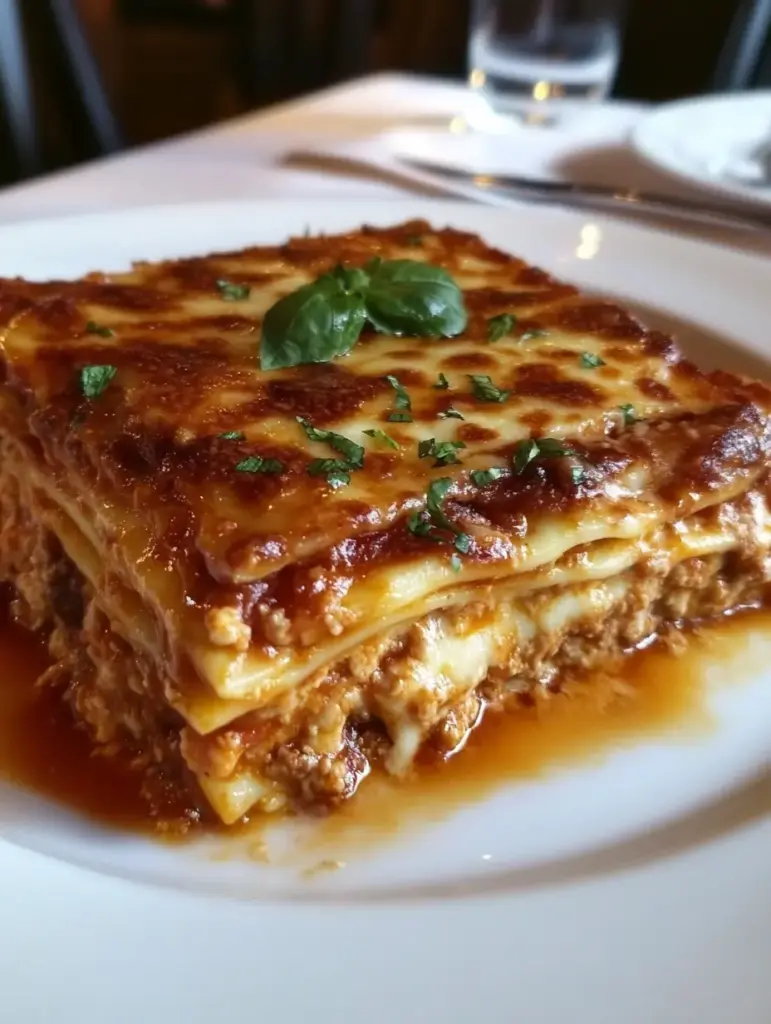I still remember the first time I made lasagna from scratch—nervous, flour on my nose, and a simmering pot of ragù filling the kitchen with the warm, familiar scent of garlic and tomatoes. It wasn’t perfect, but it tasted like love. That’s the magic of this dish: it’s more than just pasta, sauce, and cheese—it’s tradition layered with intention.
In this article, we’ll dive deep into the origins of lasagna, explore its regional variations, and break down the components that make it truly classic. Ready to layer up some flavor?
A Brief History of Lasagna
Lasagna’s history is as layered as the dish itself. Its roots trace back to Ancient Greece, where a flat sheet of dough known as laganon was used in early culinary practices. While quite different from what we know today, laganon laid the groundwork for pasta dishes to come.
The Romans took things further, incorporating layers of pasta with meats and sauces. By the Middle Ages, lasagna had become more recognizable in Italy, especially in Naples and Bologna, though the ingredients and preparation still varied greatly.
One pivotal shift came after the Columbian exchange in the 16th century, when tomatoes—native to the Americas—arrived in Europe. These vibrant fruits revolutionized Italian cooking, and lasagna was no exception. Tomato sauce became a staple layer, adding richness and tang to the dish.
Regionally, lasagna developed in two iconic ways: the meat-and-béchamel style of Emilia-Romagna, and the ricotta-laden, tomato-rich lasagna of Naples. Both styles are celebrated today, each representing a different facet of Italian culinary heritage.
Understanding lasagna’s history isn’t just trivia—it’s a way to appreciate the depth and tradition behind every comforting bite.
Regional Variations: North vs. South
Italy is a land of regional pride, and lasagna is no exception. The dish transforms as you travel from north to south, with each area showcasing its own traditions and ingredients.
In Northern Italy, especially in Emilia-Romagna, lasagna is refined and earthy. The pasta sheets are often made with spinach, giving them a beautiful green hue. Here, lasagna is traditionally layered with slow-cooked ragù (Bolognese), béchamel sauce, and a dusting of Parmesan cheese. It’s a rich, creamy dish that speaks to the northern love for dairy and butter.
Head south to Naples or Campania, and you’ll find a bolder, more rustic version. Southern lasagna often skips the béchamel in favor of ricotta cheese and hard-boiled eggs, nestled between layers of meaty tomato sauce. It may also include local sausage or meatballs for added flavor.
Why the difference? Geography and local produce. Northern Italy’s cooler climate supports dairy farming, while the south’s warmer weather yields bright tomatoes and aromatic herbs.
Both versions are delicious—and fiercely defended by their respective regions. Whichever one you choose, you’re in for a bite of Italian history and heart.
Key Components of Classic Lasagna
What makes lasagna truly “classic”? It’s the thoughtful combination of four essential components: pasta, meat sauce, béchamel, and cheese.
Pasta Sheets
Start with the foundation—lasagna noodles. While fresh pasta made from eggs and flour is ideal, dried noodles work just as well when cooked properly. Some even prefer no-boil sheets for convenience. For texture, aim for al dente; overcooked pasta turns mushy once layered.
Meat Sauce (Ragù)
A classic lasagna calls for a hearty ragù, typically made from ground beef, pork, or a combination, simmered slowly with onions, garlic, tomatoes, and herbs. This slow simmering develops a deep, savory flavor that anchors the entire dish.
Béchamel Sauce
Creamy and elegant, béchamel (a simple mix of butter, flour, and milk) softens the acidity of the tomato sauce and adds a luxurious texture. It’s especially key in the Northern style but can be used in others for extra richness.
Cheese
Parmesan adds a salty umami bite, mozzarella brings stretch and gooey comfort, and ricotta (in Southern variations) offers a creamy contrast. Shred your own cheeses if possible—pre-shredded ones often contain anti-caking agents that prevent smooth melting.
Each component plays a vital role. Layered thoughtfully, they create the signature flavor and texture that makes lasagna unforgettable.
Tips for Making the Perfect Lasagna
Perfect lasagna isn’t just about following a recipe—it’s about technique, timing, and a few insider secrets.
1. Prepare Sauces in Advance
Don’t rush your sauces. Let the ragù simmer low and slow to develop flavor, and prepare the béchamel ahead so it’s silky and lump-free. This also makes assembly much smoother.
2. Don’t Overdo the Sauce
Lasagna isn’t soup! Too much sauce, especially watery tomato sauce, leads to soggy layers. Make sure your ragù has reduced enough before using.
3. Mind Your Layers
Start with sauce at the bottom of your pan to prevent sticking. Then alternate layers in this order: pasta, sauce, béchamel (if using), cheese—repeat. Press gently between layers to remove air pockets.
4. Rest Before Serving
After baking, let your lasagna rest for at least 15–20 minutes. This helps the layers set and makes slicing neat and satisfying.
5. Use the Right Pan
A ceramic or metal pan with high sides allows for multiple layers without overflow. And always line your baking tray in case of bubbling.
Following these simple tips will elevate your lasagna from good to show-stopping.
Step-by-Step Preparation Guide
Making classic Italian lasagna may seem like a project, but it’s well worth the effort—and incredibly rewarding. Let’s walk through each step so you can feel confident from the first simmer to the final slice.
Preparation
Start by gathering all your ingredients. You’ll need:
- Lasagna pasta sheets (fresh, dried, or no-boil)
- A rich ragù (made with ground meat, tomatoes, onion, garlic, olive oil, and herbs)
- Béchamel sauce (butter, flour, milk, and a pinch of nutmeg)
- Cheeses: mozzarella, Parmesan, and optionally ricotta
Cook the ragù by browning the meat and sautéing aromatics. Add tomato sauce or crushed tomatoes and let it simmer—longer is better, at least 45–60 minutes for full flavor.
Meanwhile, prepare the béchamel: melt butter, whisk in flour to form a roux, then slowly add warm milk until smooth. Simmer until thickened and silky.
Assembly
Choose a deep baking dish (9×13 inch works well). Start with a thin layer of ragù on the bottom to prevent sticking. Then follow this layering pattern:
- Pasta sheets
- Ragù
- Béchamel sauce
- Cheese
Repeat until the dish is nearly full, ending with a final layer of sauce and a generous topping of cheese. Aim for 4–5 layers for a hearty, satisfying structure.
Baking
Preheat your oven to 375°F (190°C). Cover the dish with foil (lightly greased so it doesn’t stick to the cheese) and bake for 30–35 minutes. Uncover and bake another 15 minutes to develop that golden, bubbly top.
You’ll know it’s ready when the edges are gently bubbling and the top is beautifully browned.
Resting and Serving
This part is important—let the lasagna rest for at least 15–20 minutes before slicing. This helps the layers set and makes serving much cleaner.
Pair it with a crisp arugula salad, some garlic bread, and you’ve got a meal that’s both rustic and elegant.
Serving Suggestions and Pairings
Lasagna is rich and satisfying on its own, but pairing it with the right sides and drinks can turn your meal into an Italian feast.
For wine, go for something bold enough to stand up to the meat and cheese. Chianti, Barbera, or Sangiovese are all excellent choices—they bring acidity and fruitiness that complement the lasagna’s richness.
On the side, a simple arugula salad with lemon vinaigrette offers freshness and balance. Roasted vegetables, such as zucchini, bell peppers, or eggplant, make wonderful, flavorful companions.
Presentation-wise, serve lasagna in generous squares on warm plates, with a sprinkle of Parmesan and a fresh basil leaf on top for a pop of color. Add a rustic bread basket, and your guests will feel like they’re dining in a family-run trattoria in the heart of Italy.
Storage and Reheating Tips
Lasagna is one of those rare dishes that tastes even better the next day. Here’s how to store and reheat it without sacrificing flavor or texture.
Refrigeration: Once cooled, cover tightly with foil or store in an airtight container. It will keep in the fridge for up to 4 days.
Freezing: For longer storage, cut into individual portions, wrap them in plastic wrap and foil, and freeze. Lasagna freezes well for up to 3 months.
Reheating: For best results, reheat in the oven at 350°F (175°C), covered, for 20–25 minutes. You can also use the microwave in short bursts, but it’s best to let it come to room temperature first to reheat evenly.
Avoid reheating multiple times, as this can dry it out. A splash of water or sauce before reheating can help restore moisture.
Frequently Asked Questions (FAQs)
Can I make lasagna ahead of time?
Absolutely. In fact, making it in advance allows the flavors to deepen. Assemble the lasagna, cover tightly, and refrigerate for up to 24 hours before baking. You can also freeze it unbaked—just thaw overnight in the fridge before cooking.
What’s the difference between béchamel and ricotta in lasagna?
Béchamel is a silky, buttery white sauce made from flour, butter, and milk. It adds richness and a smooth texture, especially in Northern Italian recipes. Ricotta, used more in Southern styles, is lighter and slightly grainy, giving a more rustic, airy feel to the lasagna. Both are delicious—it’s all about preference!
How do I prevent watery lasagna?
The key is reducing your sauces properly. A too-wet ragù or unstrained ricotta will create excess moisture. Also, drain any cooked vegetables like spinach thoroughly. Letting the lasagna rest after baking also helps the layers firm up and absorb liquid.
Can I use no-boil noodles?
Yes, and they’re a time-saver! Just make sure your sauces are a bit looser, as no-boil noodles absorb more liquid while baking. Covering your dish with foil for most of the bake time helps ensure even cooking.
How many layers should a lasagna have?
Traditionally, 3 to 5 layers is the sweet spot. More than that can get messy or unstable, but if your pan is deep enough and you’re feeling ambitious—go for it!
Print
Classic Italian Lasagna Recipe
A rich and comforting Classic Italian Lasagna layered with savory ragù, creamy béchamel sauce, and melted cheese—perfect for family dinners and special occasions.
- Total Time: 1 hour 45 minutes
- Yield: 8 servings
Ingredients
- 12 lasagna pasta sheets (fresh, dried, or no-boil)
- 1 lb (450g) ground beef or pork (or a mix)
- 2 cups tomato sauce or crushed tomatoes
- 1 small onion, finely chopped
- 2 cloves garlic, minced
- 2 tbsp olive oil
- Salt and pepper, to taste
- 1/2 tsp dried oregano
- 1/2 tsp dried basil
- 1/4 tsp red pepper flakes (optional)
- 2 tbsp butter
- 2 tbsp all-purpose flour
- 2 cups whole milk, warm
- 1/8 tsp grated nutmeg (optional)
- 1 1/2 cups shredded mozzarella cheese
- 1/2 cup grated Parmesan cheese
- 1 cup ricotta cheese (optional, Southern style)
Instructions
- Preheat oven to 375°F (190°C). Grease a 9×13 inch baking dish.
- Heat olive oil in a pan. Sauté onion until translucent, add garlic, then the ground meat. Cook until browned.
- Add tomato sauce, herbs, salt, pepper, and simmer for 45–60 minutes.
- For béchamel: melt butter, whisk in flour to form a roux, then slowly add warm milk. Cook until smooth and thickened. Season with salt and nutmeg.
- If using dried pasta, boil until al dente. Drain and set aside.
- Begin assembly: Spread a layer of ragù on the dish bottom. Add pasta sheets, a layer of béchamel, then mozzarella and Parmesan (add ricotta if using). Repeat for 4–5 layers.
- Top with sauce and cheese. Cover with greased foil.
- Bake for 30–35 minutes covered. Remove foil and bake for 15 more minutes until golden and bubbly.
- Remove from oven and let rest 15–20 minutes before slicing.
- Serve with garlic bread and salad, if desired.
Notes
- Lasagna tastes even better the next day—perfect for meal prep or leftovers.
- Use freshly grated cheese for best texture and flavor.
- Letting the lasagna rest after baking prevents it from falling apart when sliced.
- To freeze: wrap individual portions well and store up to 3 months.
- Adjust sauce consistency if using no-boil noodles.
- Prep Time: 45 minutes
- Cook Time: 1 hour
- Category: Main Dish
- Method: Baking
- Cuisine: Italian
- Diet: Vegetarian
Nutrition
- Serving Size: 1 slice
- Calories: 420
- Sugar: 6g
- Sodium: 650mg
- Fat: 22g
- Saturated Fat: 11g
- Unsaturated Fat: 9g
- Trans Fat: 0.3g
- Carbohydrates: 32g
- Fiber: 3g
- Protein: 24g
- Cholesterol: 65mg



